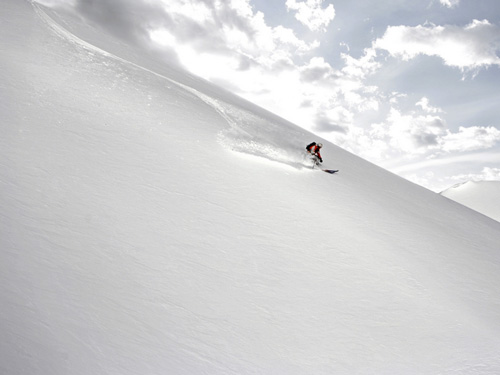The vast majority of recreational skiers get out on the slopes once or twice a year during the winter season. As skiing is a relatively easy sport to learn and progress quickly in, enjoyment levels are extremely high even for first time beginners. That’s why we all get hooked!
But transcending the ability levels from intermediate to expert status is not always an easy path. There are many excellent courses now available that enhance your technical ability and knowledge of the sport and they are delivered in a highly professional and structured way. Some of these courses are tailored to specific requirements like ‘carving’ or ‘break through the fear barrier’. There are also courses available for skiers who would like to break away from the familiar territory of the marked ski run and try out what we all refer to as ‘Off Piste Skiing’.
This term is of course taken from the French for ski run (Piste) and simply means we are leaving the boundary of the resorts graded area into relatively unknown terrain and snow conditions. In North America, it is referred to as ‘Backcountry Skiing’, simply because much of the un-marked terrain of the resort is on the ‘backside’ of the mountain. This term has been adopted by many UK skiers more recently. The term ‘Freeride’ is now ubiquitously used to refer to skiing off-piste and pushing the limits of the terrain and technique of the skier.
If we hang around the bars of many of the large ski resorts in the evenings and eavesdrop on the conversations of ski bums and resort workers we might hear tales of ‘epic powder’ days or ‘bottomless snow conditions’. Powder snow is the elixir of the mountains and the reason many skiers get up in the morning. But when skiing off piste we encounter many different types of snow conditions. Even powder snow can be broken down into several unique categories that change the properties of the snow enormously. This is influenced by weather conditions, slope aspect, gradient and the amount of people that have already descended the slope.
Deep, light snow that has not yet been skied at all is what every ‘off piste’ skier is searching for. A heavy snowfall in cold temperatures without too much wind will create the best conditions for this scenario. And of course so is getting up early to avoid the rush so you get the first tracks down the mountain.
So you are ready to take on the challenges of skiing off piste? In recent years there has been an increase in off piste skiing due to advances in equipment technology that aid skiing in deep snow, better instruction and increases in skier development due to more time on the snow.
Skiing off piste in powder snow conditions can be one of the most exhilarating experiences you will ever have, but there are also several key points to consider before starting off:
Ski technique
We will look at how to tweak your ski technique so you can start skiing off piste in all conditions.
Mountain Safety
Marked ski runs are patrolled and only open when there is no danger of avalanche. Once you leave the marked area these rules do not apply and therefore you must only ski off piste with a qualified instructor or guide unless you have the relevant experience and qualifications yourself.
Environment
The mountains have fragile eco systems which must be respected and you should always check with the resort authorities of skiing in certain areas is permitted.

Here is a list of the typical snow conditions that you might encounter when skiing off piste:
Bottomless powder
This is the ultimate skiing experience. The snow is light and so deep you don’t touch the bottom. You will float down through the snow as it piles over the top of your head. Exhilarating and challenging, the rewards are a secret to those only who have been there. Be aware, lots of snow like this can create high avalanche risk.
Spring Snow
Also known as corn snow, these conditions form after a period of melt and re-freeze that takes several days. The result is a beautiful soft and velvety layer of melted snow on top of a more solid base. Easy to ski and great fun too.
Boot Top Powder
Like bottomless powder but less deep. Fun to ski and a little easier than the deeper version.
Heavy or Wet Powder
If the temperature rises powder snow can become heavy due to more water content. This makes it harder to ski through. Depending on how heavy it has become it can still be fun to ski. Be aware though that this type of snow is particularly vulnerable to avalanches.
Wind blown snow
Not all off piste skiing is easy! Snow that has been affected by the wind often forms a thick crust on top. When skied, the skier breaks though this crust into the softer snow underneath. It’s then very tricky to control the skis. If you can ski this stuff well then you can ski anything.
Ice
Occasionally you will encounter real ice off piste. This is not the kind of ‘Ice’ that is experienced on piste, that’s usually just hard snow, but real ‘blue’ ice that is solid as a rock. Simple solution, avoid completely. Usually found only on Scottish mountains.
Remember: Always ski off piste / back country / un marked terrain with a fully qualified guide or instructor.
